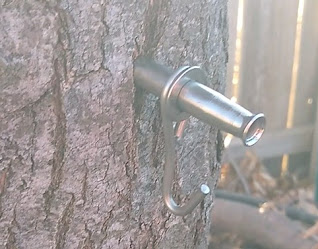Each year at the end of winter and beginning of spring, there are a few weeks of magic that happens. Tree sap starts to flow, bringing life from the roots back into the branches. Farmers across the northern US and Canada collect sap from their maple trees as they have for over two hundred years.
The sap is collected and usually taken to their "Sugar Shack." There, this barely sweet, clear sap is boiled down using time-honored methods passed down from generation to generation to produce the sweet, dark maple syrup we use on pancakes, waffles and more.
You can also take part in this historical tradition right in your own backyard (or a friendly neighbors)!
 |
This week's forecast looks great! |
 |
| Our Maple Tapping Display at the 2016 Home & Outdoor Living Show |
Buy your Spiles, or Tree Taps, just like mine - HERE
 |
This video from our backyard tree demonstrates a simple "how-to" tapping method for you-
From the Northern Midwest to New England and into Canada, the sap is boiled down into Maple Syrup. This is often done in large pans over an open flame outside, as boiling sap into syrup produces a lot of steam. And it takes a lot of fuel. Sap is continuously added as the water is boiled off, carefully making sure it doesn't boil over or burn the pan. It typically takes around 40 gallons of sap to make one gallon of syrup.
If you have access to enough trees and want to try making some syrup yourself, here is a great guide from the University of Maine Extension Service.
How to Tap Maple Trees and Make Maple Syrup (link)
You can learn more about Drinking Maple
(and other sap) at Chelsea Green (link)
If you want to experience it in person the Indian Creek Nature Center near Cedar Rapids is having a Maple Syrup Festival on March 23 & 24 this year.
41st Annual Maple Syrup Festival (link)
Enjoy the tastes of the season!



No comments:
Post a Comment